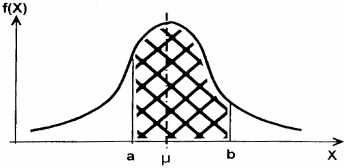CONTINUOUS RANDOM VARIABLES
CONTINUOUS RANDOM VARIABLES
As we have mentioned earlier, discrete random variables are represented by isolated real-valued numbers . Manipulation of discrete random variables involves summations of these discrete values. This is illustrated for the frequency of outcomes in k- cells ; n = total number samples.
Probability density function (pdf): f(X k ) = ![]()
Cumulative distribution function (CDF) (sum)

Mean

Variance


ADVANTAGES OF CONTINUOUS RANDOM VARIABLES
-
Integrals (areas) of continuous r.v. x yield closed form equations that are easy to manipulate and to analyze.
-
Integrals of standardized distributions can be tabulated.
Probability density function (pdf): f (x) where probabilities are only defined as the area within an interval.

Two constraints of a probability density function: f (x)
-
Positive value: f(x)
-
Unit area:
 f ( x ) dx 1
f ( x ) dx 1
Cumulative distribution function (CDF): F(x) = ( P (- ˆ < X x ) = ![]() f ( x ) dx
f ( x ) dx
f(x) = dF(x)/dx
These functions may be represented by the graphs in Figure 16.6.

Figure 16.6: The probability (left) and cumulative (right) functions.
PROPERTIES OF CONTINUOUS DISTRIBUTIONS
-
Probability is defined only in the context of an incremental range of the random variable [a x b].


-
Probabilities cannot be determined for a point x , since the interval of integration or the base (b - a) is zero.
-
Probabilities can be determined from either the probability density function f(x) or the cumulative distribution function F(x).
-
The CDF is more important because tabulated values of the various standardized or normalized probability distributions models presented in this form.
-
Mean:

-
Variance:

EAN: 2147483647
Pages: 252